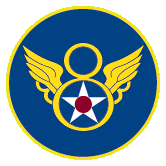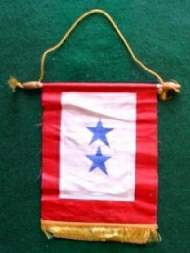 THE BROTHERS VAN SICKLE
THE BROTHERS VAN SICKLE
 Capt.Frank and Dick VanSickle with unidentified pilot". |
 On September 8th., 1944 two new pilots arrived at King's Cliffe to join the 77th. Fighter Squadron. Hailing from Fife Lake, Michigan, their names were Lt. Dick W. Van Sickle and his younger brother Lt. Frank L. Van Sickle, Jr. Just a little over a week later they were in action over the Arnheim area as part of a mission providing cover for B-24s dropping supplies to Airborne troops on the ground. Though they didn't encounter any enemy opposition in the air they did get their first taste of heavy flak from the well concealed German emplacements below them. On September 8th., 1944 two new pilots arrived at King's Cliffe to join the 77th. Fighter Squadron. Hailing from Fife Lake, Michigan, their names were Lt. Dick W. Van Sickle and his younger brother Lt. Frank L. Van Sickle, Jr. Just a little over a week later they were in action over the Arnheim area as part of a mission providing cover for B-24s dropping supplies to Airborne troops on the ground. Though they didn't encounter any enemy opposition in the air they did get their first taste of heavy flak from the well concealed German emplacements below them.� � It took less than a month for the brothers to draw blood as on October 6th. they completed their assignment escorting the heavies and the Group hit the deck to attack targets of opportunity. Several sea-plane anchorages were uncovered and the 20th. FG went to work. Dick was credited with damaging a Dornier DO-18 and destroying another. This was part of the Group's biggest day up to that time, over 40 aircraft were destroyed and 14 damaged. Everyone returned safely from the mission. � � The brothers continued prowling the skies together throughout the winter of 1944-45 and on January 14th. 1945 the following entry was made in the group's history: " The brothers Van Sickle divided the air and ground between them, the elder brother knocking off an Me-109 upstairs, while Junior accounted for 1 locomotive destroyed and one damaged, obviously on the ground."On January 30th. Dick was promoted to Captain. � � On February 20th. Frank (who had somehow gotten the nickname "Little Motorcycle",)did not return from the mission over Nurnburg. While Dick strafed the airfield at Straubling, adding to his tally of enemy aircraft destroyed on the ground, Frank and Lt. Albert North reportedly destroyed four enemy aircraft in the air. Confirmation of the latter feat was not quick in coming as both North and Frank landed safely at Etampes Airfield in France and did not return to the base for two days. � � Upon their arrival back at King's Cliffe, North and Frank reported that they had spotted the shadow of an Me-108 trainer flying aprox. 100 feet off the ground. Frank promptly knocked it out of the air and then spied three more flying close by. Lt. North downed one of these, the second escaped and the third made the mistake of heading for home, which led them to a grass field. "To show their appreciation," the daily mission report reads, " Van destroyed the plane and the pilot while he was taxiing down the field." Further investigation by North and Van Sickle led to the discovery of eight more aircraft under camoflage around the field. There was no flak in the area so the boys methodically destroyed five and damaged two. All told on this one mission the claims were as follows: Lt. Frank Van Sickle - Destroyed- 1 Me-108 (air); 1 Fi-156, 1 Me-108, 1 Unidentifeid twin engine (ground), Damaged- 1 unidentified single-engine (ground). Lt. Albert B. North- Destroyed- 1 Me-108 (air): 1 Me-108, 1Me-109, 1 unidentified single-engine (ground), Damaged- 1 unidentified single-engine (ground). � � On March 21st. Frank received his Captain's bars and ten days later their combat tours were completed. Posted in the mission report for 03 March, 1945 was the following: ...Besides providing safe conduct for a he** of a lot of bombers across enemy held territory, the Van Sickles have inflicted damage on the enemy as follows: Capt. Frank: 1 Me-108 destroyed in the air; 1 Me-108, 1 Fi-156 and one unidentified S/E, one unidentified T/E destroyed on the ground. Capt. Dick: 1 Me-109 destroyed in the air; 1 Do-18 destroyed on the water, one Do-18 and 1 He-111 destroyed on the ground (or water.)" � � Both returned to the United States on 12 April, 1945. Both had flown one complete tour of duty, a total of 288 combat hours for Dick and 307:45minutes for Frank. Both men were awarded Distinguished Flying Crosses and Air Medals with six clusters. During Korea, Frank was killed in an F-80 while a member of the 16th FS, 51st FG. � � A third brother, Don, also served during the war, his first unit (prob. at Ft. Custer, Michigan) being the 7th Engineers (CE), an old WWI unit which later went to Iceland and reputedly was later chewed up at Remagen. After going on maneuvers in Tenn. (Jun '41) and Ordnance training in LA (Aug-Sep '41), he left the 7th for Engr.OCS at Ft. Belvoir, VA. After graduation, 2LT VanSickle went to Westover Field, Mass. A unit returning from Greenland didn't need him, and he went next to Richmond, VA, where he was given command of G Co., 21st Engr. Regiment with a promotion to 1st Lt (approx. Aug '42). Walking back to base the evening of the next day, he was hit by a drunken deuce-and-a-half driver. After recuperation (and after losing several months of the promotion to 1st.Lt.), he wound up in Dyersburg, TN from Feb. '43 to Aug. '43--it was here that he hooked up with the 853rd Bn. From Dyersburg, Lt. VanSickle went to Mobile, AL (Aug. '43) and departed from Newport (VA?) 3 Oct 43 on a Liberty ship in a convoy bound for Africa. He survived the sinking of the HMT Rohna, where 1,015 of the 2,000 troops in passage were lost. � � Don's son, Mark (who has provided much of the information of this page,) who continued the proud military history of the family, served in Vietnam. |
Unless otherwise noted, all content � copyright The Art of Syd Edwards 1998-1999. All rights reserved and reproduction is prohibited.
